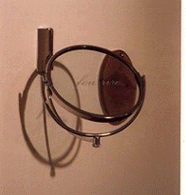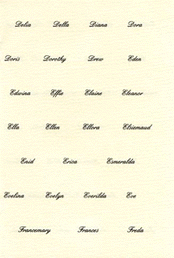 chimera
chimera
I am revisiting a former love. It is nine years since I made this work and eight years since I have looked at it last in any sense of a real presence. I have held up my slides to the light in order to verify their content. I have seen the image of this work from the corner of my eye as I stood facing an audience. Those watching saw it better than I, for I was choosing my words with care. I have to find a way to approach it now, uncertain as to my feelings for it after so long an absence, so great a distance. I designated it as past, and like all one believes to be done with, it has returned.
I do not know if I will recognise it. I am sheltered from forgetting entirely however - the catalogue, the slides, are testimony. I could describe it: two large photographs - I am speaking from memory - a blonde woman, a dark man. More about them: she is fine featured, sharp even, a mass of enviably curly hair (she has had her cut since the picture was taken); he is equally exquisite, almosfeminine to her slight hint of masculine attributes, long, straight, dark hair (his too has been cut since. Though I have not seen him for nine years, one year- orperhaps two years - ago, I was sent from Campobasso a photograph of three people, all of whom I met in Rome. The man in my photograph was of course one of them - the inscription on the reverse of the image said how its photographer had met V. by chance and it had turned out that V. used to be a hairdresser in Rome where he met me).
I was pleased to receive the photograph but I still have not thanked the sender. I do not know what to do with this new version of an old acquaintance, do not know what may be called for. The woman I see more frequently. Neither she nor he have ever met, though she too lived for a short period in Rome. There is no symmetry nor reciprocity between them or their positions. In the field of vision she will hold the place of a woman, and he, more ambiguously, that of a man. Someone - for the moment it is I - will name them woman and man, and someone else - let me suppose it to be the viewer - will identify with one or other in order to confirm his or her own position. It is, of course, important to symbolise the function of man and woman if one is to maintain a finished sexual position, situating oneself as one or another. It is important precisely because of the precarious nature of sexual identity.
Love will be directed towards one who appears to have what one does not have oneself. The other does not have what one lacks either. From the little I can remember now, I wanted the photographs to be set up as lures, a word for which one might substitute also Œdecoy1 or Œbait1. I wanted something I did not have from another who could not meet my demand (for that is the condition of the relation) despite all the seductive manoeuvres upon which the arrangement insisted. I imagined that the images could allure, entice, and that the other (let me suppose that to have been the viewer) would have to call upon all his or her strategies of resistance to avoid being ensnared.
There was a little detail - a counterpart to the work. While part of the work, it also split the work, was cut out of it in a manner of speaking. There were two small lightboxes, sections of each face, just their eyes. Hung into a corner, they reflected each other endlessly, were themselves trapped into reflection. I am supposing now that this was my intention then. This caused a blind spot, set in operation by a Œpure1 gaze, one that was a priori emptied of sight, in opposition to the large photographs which held the condition of a possibility for the return of the gaze. It was a Œflick flick1, the on/off movement that both makes seeing possible and gives respite from sight.
I do not know what I will feel now, seeing it again. At the time I wrote that I wanted another image, that of the viewer who looked from woman to man to ... and so on, that I wanted to link, break, rejoin. It is the sort of thing one
says when in love, and later one will have cause to regret it, particularly when one reads one1s words quoted under quite different circumstances. At worst, the work will be re-encountered as a grotesque product of imagination, produced by a grafting of two impossibilities, a mutation. At best, the work will be a fabulous thing, and capable of responding to fancies and fantasies. I feel a wild fluttering, both fearful and excited.
Sharon Kivland
1999
